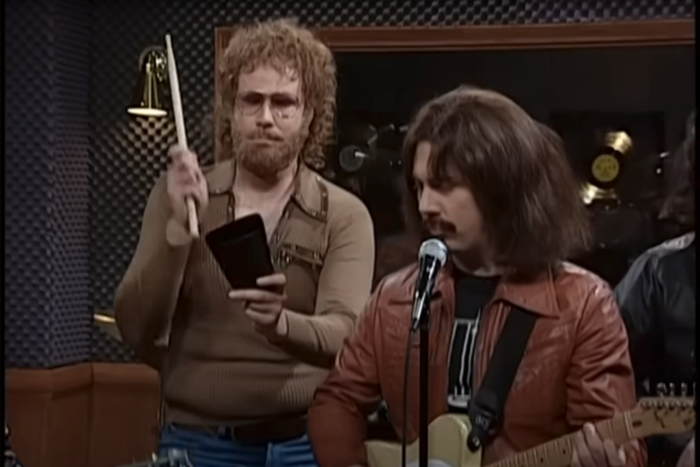
SNL50: Beyond Saturday Night, the new Peacock docuseries that celebrates the 50th anniversary of SNL, consists of four episodes, each focused on a specific backstory about the late-night comedy mainstay. But if you’re pressed for time, there’s only one that is really a must-watch: “More Cowbell,” a detailed account of the conception and influence of the season-25 sketch about the recording of the Blue Oyster Cult rock classic “(Don’t Fear) the Reaper” that first introduced society to the sight and sound of Christopher Walken declaring, “I have a fever, and the only prescription is more cowbell.” Directed by Neil Berkeley (Gilbert, Group Therapy), the episode is also the shortest of the four, which is to say it does what the best SNL sketches do: use its time efficiently.
It also doesn’t treat its subject with sloppy or excessive reverence, a potential pitfall in any tribute to a pop-cultural phenomenon produced within the same corporate family that takes credit for that phenomenon. The episode is framed with a hyperbolic, documentary-style voice-over from former SNL cast member and current announcer Darrell Hammond that’s very similar to the one that opens the beloved sketch. “On the eighth day of April in the year 2000, a message was delivered that would change the world,” Hammond says with deadpan gravity at the beginning of the episode. “A message of strength and conviction. Words of wisdom that shaped the lives of generations to come.” Cut to Walken, as producer Bruce Dickinson, telling the members of the SNL version of Blue Oyster Cult, “I could have used more cowbell.” Immediately, the episode establishes that it plans to take its subject seriously, while also recognizing how ridiculous it is to take seriously the sight of Will Ferrell banging frantically on a cowbell with his hairy belly poking out of a deliberately tight shirt.
As expected, the episode walks through the creation of the sketch, which was inspired by Ferrell’s curiosity about the mythical man who so persistently beat the shit out of a cowbell on that 1976 track. The docuseries walks us through the path the sketch took to getting on the air — how it got shelved before making it into the episode Walken hosted, how badly it went over during dress rehearsal — and occasionally dips into cliché as it attempts to explain its impact. Jimmy Fallon’s comment that the sketch was “like lightning in a bottle,” an analogy that no one else has ever used in a documentary ever, easily could have been cut.
But to its credit, the episode is interested in more than just what SNL cast members have to say about this catchphrase-spawning ode to the creative process. Specifically, this episode is really, really interested in cowbells. There’s footage of cowbells being manufactured at Ranco, the same company whose brand appears on the cowbell that Ferrell played — assaulted? — in the sketch. The original purpose of the cowbell, to warn farmers when their cows wandered away from the herd, is briefly touched upon, prompting Dave Grohl, one of multiple musicians interviewed for the episode, to say with something close to awe: “I can’t believe you’ve done this much fucking research into cowbells.”
Best of all, the episode devotes a solid chunk of time to conversations with the members of Blue Oyster Cult and the producers of the track, none of whom, by the way, are named Bruce Dickinson. (As the docuseries explains, Ferrell took Dickinson’s name from the credits on a Blue Oyster Cult CD without realizing he was only involved in producing a remastered version of the track, not the original.) The actual producers can’t even agree about who should take most of the credit for working on the song. David Lucas, famous for his flair for commercial jingles, insists he was the primary producer, while another guy, Murray Krugman, says he should be credited as the lead on production. When Berkeley confronts Lucas with Krugman’s claims, Lucas responds dismissively: “Murray read the paper and drank coffee.” All of this adds a This Is Spinal Tap–ish element to the proceedings; it’s almost as if a separate, unintentional SNL sketch is taking place within this documentary about a SNL sketch.
While the other Beyond Saturday Night episodes range from fun but not terribly revelatory (“Five Minutes,” a look at the audition process) to informative but not that exciting (“Written By: A Week Inside the SNL Writers Room”) to wonderfully niche (“Season 11: The Weird Year”), the “Cowbell” chronicle best captures the spirit of SNL by illustrating its team’s ability to turn the silliest ideas into something sublime. Theoretically, it’s possible to absorb some of the tidbits shared in the “More Cowbell” episode simply by doing a little internet research: on Wikipedia, in this oral history of the song by GQ, or in this interview with Blue Oyster Cult co-founder Donald “Buck Dharma” Roeser published here at Vulture. But seeing the whole story laid out in one spot, in a visual format that allows fans to revisit the sketch while hearing the story behind it, is a special treat that succeeds at what the whole SNL50 project is attempting to achieve: making us appreciate this show for what it can give us when it’s operating at its highest, stupidest potential.


